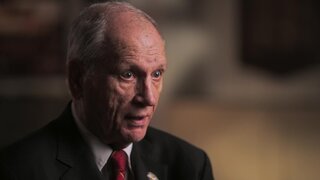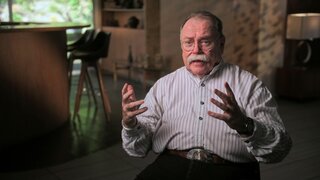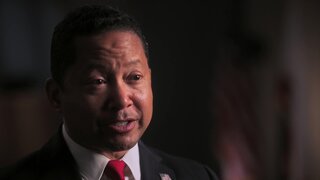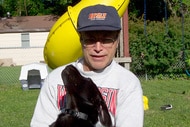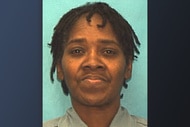Create a free profile to get unlimited access to exclusive videos, breaking news, sweepstakes, and more!
"High Priest of Silent Cinema" Killed in Business Partner's Murder-For-Hire Plot
Lawrence Austin, owner of the Silent Movie Theatre in Los Angeles, was gunned down in a twisted conspiracy that could have come from a Hollywood thriller.
On January 17, 1997, the Silent Movie Theatre in Los Angeles was celebrating its sixth anniversary when the festive vibe was shattered by gunshots.
Detectives found that the establishment's owner, Lawrence Austin, 74, had been fatally shot. Mary Giles, 19, a concessions clerk, was also shot but was alive. She was rushed to the hospital.
Austin had “three distinct bullet wounds, including one in the head,” Los Angeles Police Department Detective John Miller told Real Murders of Los Angeles, debuting October 6 at 9/8c on Oxygen.
Robbery-Gone-Wrong Initially Suspected
A bag of blood-spattered cash, about $500, was near Austin’s body. “We were open to the possibility that it was a robbery gone bad,” said LAPD Detective Alan Hamilton.
RELATED: Real Housewife Garcelle Beauvais to Narrate the Real Murders of Los Angeles This Fall
The gunman ran through the crowded theater and out the back alley, according to witnesses. “It’s almost as though this individual wanted to be seen,” added Hamilton.
As a crime scene team processed the theater, projectionist James Van Sickle offered his assistance. Investigators learned that the theater had been founded in the 1940s and was the only one in the U.S. devoted solely to silent films.
The business had shuttered for a number of years. In 1991, Austin, who'd fallen in love with the theater as a kid in high school, took it over. “He just breathed new life into it,” said Los Angeles crime historian Joan Renner.
Austin was “the high priest of silent cinema,” his friend Chris Perkins told Real Murders of Los Angeles.
Shooting Survivor Recalls the Gunman
On January 18, detectives hoped to interview Giles, who may have been the only person to see the shooter. Lucky for her and the case, the bullet entered her chest and went to her shoulder without hitting vital organs.
Giles recalled that a guy came in and asked to speak with the manager. When Austin stepped forward, the perpetrator pulled a gun and demanded cash. Austin immediately obliged but was shot anyway. Then Giles was shot.

Giles had a clear recollection of what this individual looked like, said Hamilton. She didn’t recognize him, and he was Hispanic.
Detectives were puzzled as to why the gunman opened fire when he was given no resistance. Was it really a robbery? Or a targeted attack?
On January 20, detectives spoke with Austin’s nephew. He reiterated that the theater enabled “him to be part of the legacy of Hollywood,” said Miller.
Like the movies, parts of Austin’s life turned out to be make-believe. “Larry often told people that his dad and his uncle were silent film actors and his mother was a seamstress for the great director Cecil B. DeMille,” said Renner. “None of that was true.”
Had Austin crossed someone with his lies? Detectives dug deeper. “We determined that he actually served time for embezzlement at a company that he worked at years prior to his ownership of the theater,” said Hamilton.
Had Austin embezzled money to cover the costs of his beloved business? Investigators considered the possibility.
At the same time, the case caught the attention of America’s Most Wanted. The show interviewed detectives as well as Van Sickle.
The true-crime show also provided a sketch artist to create a drawing of the shooter. The picture was released to the media, while the LAPD offered a $25,000 reward.
Suspicion Falls on Business Partner James Van Sickle
Investigators scrutinized Austin’s business accounts. “The first thing we did was get search warrants on Larry Austin’s accounts to see what was happening,” said LAPD Detective Dave Harned, who worked in the financial crimes division in 1997.
Silent Movie Theatre assets, including cash, property and original prints and films, were worth about $3.5 million.
As they learned this, investigators also saw that money was being diverted from one of Austin's accounts. They had the bank put a freeze on it. It turned out that Van Sickle’s name was also on the account.
Van Sickle, then 34, said that he and Austin were business partners, a fact he hadn’t shared earlier. He maintained that the theater was still open and he needed money to run it. He also had Austin’s upcoming memorial to pay for, said detectives.
Van Sickle revealed that he and Austin had been lovers. “Austin was not openly gay,” said Miller. When their romantic relationship ended, the men became business partners.
In February 1997, investigators got a tip from an informant who said that 19-year-old Christian Rodriguez admitted to the theater shootings. He had a rap sheet but no violent crimes. So what was his motive?
James Van Sickle Tied to Alleged Gunman Christian Rodriguez
Detectives discovered that Rodriguez and Van Sickle had worked together, and raced to track down Rodriguez.
At the same time, they found that Van Sickle “had a sordid criminal past,” Hamilton said. He served time for selling drugs and was booked for attempted murder. The attempted murder charge was dropped when the victim failed to show up in court.
Van Sickle’s actions had a pattern, according to Hamilton. “He would establish a relationship with an older male and these relationships typically ended... with a violent encounter,” he said.
To protect their privacy, the victims may have decided not to press charges. “This is how Van Sickle could victimize people in their own community and get away with it,” said Renner.
Investigators considered that Van Sickle had his eye on Austin’s $3.5 million. They believed he hired Rodriguez, who was young and cash-strapped, to be his trigger man.
James Van Sickle's Confession is Caught on Tape
Authorities needed a confession from Van Sickle to tie him to the crime. Detectives caught a break from a confidential informant who’d seen Van Sickle on America’s Most Wanted. He claimed Van Sickle approached him months earlier about killing Austin.
At the time, the informant gave the proposition a hard pass. But now he was ready to turn on Van Sickle for the reward money, according to detectives.
Investigators recruited the informant to get Van Sickle’s taped confession. Working with detectives, the source called Van Sickle and said he read about the murder and wanted $10,000. Otherwise, he’d go to the police.
Detectives had unfrozen Van Sickle’s account. The suspect went to the bank and withdrew $10,000, and then met with the informant at an underground garage. Van Sickle was being tailed by police the whole time. He was recorded admitting that he hired a hitman to kill Austin and Giles.
James Van Sickle and Christian Rodriguez are Arrested
In March 1997, Van Sickle was arrested and charged with the first-degree murder of Austin. A day later, Rodriguez was taken into custody. Rodriguez told police Van Sickle hired him because he had no record and no one would suspect him.
Rodriguez was to be paid $25,000. In a chilling admission, he said he’d get an extra $5,000 for shooting Giles to make it look like a robbery.
Giles gave key testimony at the trial. In May 1999, Van Sickle and Rodriguez were convicted and sentenced to life without parole. The pair were also convicted of the attempted murder of Giles, in addition to attempted robbery and commercial burglary.
To learn more about the case, watch Real Murders of Los Angeles, debuting October 6 at 9/8c on Oxygen.

